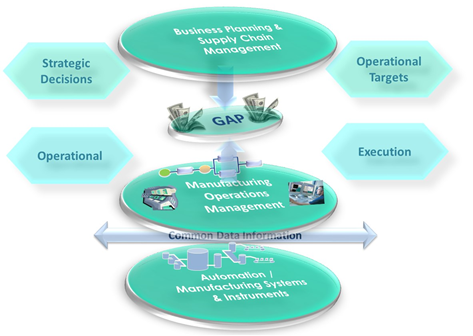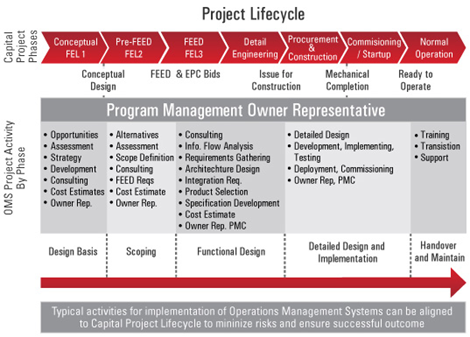

Manufacturing operations management (MOM) projects are becoming more complex and harder to manage. New technologies and their related concerns are clashing with high custom engineering costs, a shortage of qualified workers, and a poor understanding of what is required to achieve the maximum return on investment. To avoid common MOM project and lifecycle pitfalls, it helps to have a partner that can assist from the conceptual phase through operations. Recently, ARC Advisory Group spoke with MOM implementation experts at KBR and learned how that company is addressing these key concerns through an intelligent lifecycle approach.
Manufacturing operations management (MOM) systems, a subset of software systems that ARC refers to as Collaborative Production Management (CPM) systems, provide the critical interface between the process automation and enterprise levels. With new, potentially disruptive emerging technologies such as the Industrial Internet of Things (IIoT), virtualization, and cloud computing on the horizon, MOM is becoming even more important as the layer that will consolidate real-time manufacturing data and turn it into actionable information for the entire business enterprise.
![]()

Today's MOM systems address a wide range of industrial applications including historians, batch management, plant asset management, quality management, planning and scheduling, offsites automation, and more. Coordinating an effective MOM implementation is a key challenge, not only from a software implementation standpoint, but also from a business value and lifecycle management view. Many end users struggle to use their MOM implementations effectively and poor work processes can also hamstring the technology's potential value. What's more, the best-of-breed approach many organizations use for their MOM implementations often requires extensive integration and custom engineering.
MOM installations tend to be highly individualized and each plant has its unique characteristics and requirements. The ultimate configuration of the MOM system depends on the business requirements, but the key people that provide insight to these business requirements are often not directly involved in the project.
Technology is also advancing rapidly, with Industrial Internet of Things, cloud technology, virtualization, and various integration approaches such as OPC UA (OLE for Process Control Unified Architecture) making it an even more complicated landscape to navigate. Other issues such as physical and cybersecurity are now critical. With so many complications, many end users end up with an MOM implementation that does not meet their expectations, with a potentially high lifecycle cost and low return on investment.
Poor planning is the most common pitfall of MOM project management. This can include things like a flawed project scope, scheduling issues, lack of resources, poor risk management, and more. In the project execution phase, many end users make the mistake of rolling out too many applications simultaneously.
As with automation system implementations, change order costs can be an issue with MOM implementations. To reduce change order costs, it helps to involve an experienced partner in the MOM project right from the conceptual phase. Various types of partners can fill this role. Automation suppliers can have a deep knowledge of their own offerings but may lack comparable knowledge of third-party applications and/or the end user's specific business and industry requirements. Systems integrators can have deep project knowledge but may not be able to provide a comprehensive lifecycle perspective on the project that bridges the gap between project startup and day-to-day operations.
According to the company, KBR's Automation and Process Technologies (APT) group can fill this role as a core MOM implementation partner that can provide a broad scope of industry and project expertise. KBR's strategy is to provide a multi-generational plan for MOM implementation from conceptual design through FEED (Front End Engineering Design) and implementation while also providing integration expertise from both the automation and enterprise system layers. Determining how automation will interact with both MOM and ERP is key to maximizing business value. KBR can also manage the overall project, providing management in the hiring of systems integrators, detailed design, and more.
KBR has developed a large staff of subject matter experts (SMEs) in functional and technical areas to bridge the gap in knowledge, expertise, and understanding between internal customer stakeholders, EPCs, system integrators, and software suppliers. With headquarters in Houston and offices in Pune and London, the company has experts all over the world that cover everything from MOM project methodology to areas like automation, production planning, material and energy balance, laboratory information management systems (LIMS), and even inventory management systems.

On the project management consulting (PMC) side, KBR has its own well-defined business process standards with a single repository. To date, KBR has done many MOM projects in a wide range of industrial facilities including refineries, chemical plants, liquefied natural gas (LNG) plants, ammonia plants, and specialty chemical plants.
The company can assist with the software and hardware supplier selection process. As an engineering company, KBR can effectively manage the contracting and procurement process in addition to the implementation and integration tasks. The company embraces standards where appropriate and uses the ISA-95 standard and reference model for MOM.
KBR also brings a quality assurance approach to projects; aligning the requirements of end users and owner-operators with the various third parties, from systems integrators to technology suppliers. The company also has an extensive review and approval process.
KBR's approach combines up-to-date information along with a standard repository of best practices and comprehensive training. For project execution methodology, KBR brings standard templates and tools. KBR can also ensure that the front-end engineering and design (FEED) aligns with the actual project, and can assist in the information handover process from project completion to startup and operations. This helps ensure that end users are presented with the most up to date plant information, which eases training and provides better return on investment. KBR can also coordinate training with systems integrators and suppliers so everybody is on the same page.
When undertaking MOM projects, organizations must carefully consider the many different elements that encompass people, processes, and technologies. In ARC's view, to maximize end user business value, potential partners must be evaluated not just on their ability to execute the project, but also for their knowledge of a broad range of industry applications and technologies from different suppliers, their ability to employ standards and best practices, and employ a true lifecycle approach. KBR's APT group appears to understand these requirements.
All signed-in ARC Advisory Group clients can view this report in pdf format at this Link
If you would like to buy this report or obtain information about how to become a client, please Request ARC Info
Keywords: Manufacturing Operations Management, MOM, CPM, KBR.

